Runaround
| Line 16: | Line 16: | ||
Gary Crowley (''Poparound'' version) | Gary Crowley (''Poparound'' version) | ||
| - | Johnny Vegas (Sport Relief one-off) | + | [[Johnny Vegas]] (Sport Relief one-off) |
== Co-hosts == | == Co-hosts == | ||
| Line 40: | Line 40: | ||
== Synopsis == | == Synopsis == | ||
| - | + | ''Runaround'' was a very fast moving quiz with eye-searingly bright set. | |
At the start of the show, we were introduced to the ten children in the game, with the usual kiddie's mini-CV of name, age, where from, hobbies and interests, complete with a cheesy "thumbs up" to the camera usually. | At the start of the show, we were introduced to the ten children in the game, with the usual kiddie's mini-CV of name, age, where from, hobbies and interests, complete with a cheesy "thumbs up" to the camera usually. | ||
Revision as of 12:13, 5 December 2006
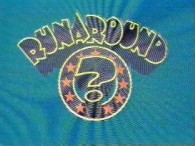
Contents |
Host
Mike Reid (1975-6)
Leslie Crowther (1977?)
Stan Boardman (1977?)
Mike Reid (1978-81)
Metal Mickey (one-off special)
Gary Crowley (Poparound version)
Johnny Vegas (Sport Relief one-off)
Co-hosts
Voiceovers: James Montgomery, Eve Thomas
Jude Hackett
Bill Gamon
Tim Edmunds
Garry Rice (Poparound, also question-setter)
Broadcast
ITV (Southern), 1975-81
Poparound spinoff: 1985-6
Synopsis
Runaround was a very fast moving quiz with eye-searingly bright set.
At the start of the show, we were introduced to the ten children in the game, with the usual kiddie's mini-CV of name, age, where from, hobbies and interests, complete with a cheesy "thumbs up" to the camera usually.
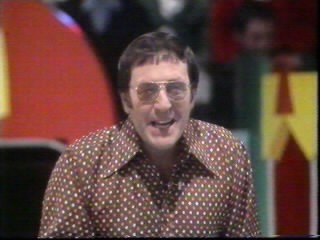 Would you buy a used car from this man? It's Mike Reid
Would you buy a used car from this man? It's Mike ReidThe host would read out a general knowledge question, to which there were three answers offered on panels at the back of the studio, written in a glorious curvy 1970s font. He would then say "G-g-g-g-go!!", which meant that the kids could run from their little semi-circular home base across to one of three big circles on the floor.
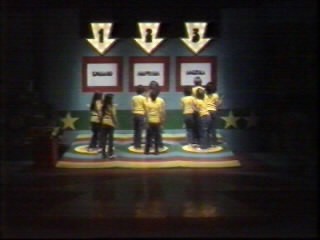 1, 2 or 3 - come on, bet bet bet!
1, 2 or 3 - come on, bet bet bet!Very straightforward so far, but here's the clever bit. Having made their choice, they would have a couple of seconds (at the most) to "Runaround" by leaping into one of the adjacent circles should they wish to do so. Hence, you could "give your opponents the runaround", in case you think someone is just trying to follow what you did. During this bit, the lights would dim right down, and the correct answer was then revealed by the appropriate arrow lighting up. There was also an almighty computer-ish sound effect which said the correct answer, which sounded like a sound engineer had accidentally left all the echo and reverb knobs on full blast ("One-ne-ne, one-ne-ne")
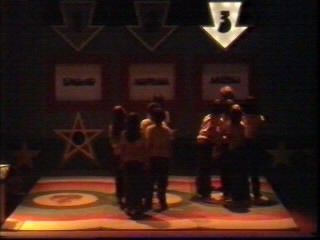 Three's a charm
Three's a charmRight answers gained you one point (indicated by a yellow ball), unless you were the only person in the correct circle (in which case you got a red, two-point ball).
A wrong answer meant you had to go into the dungeon and stay there until only one child was left. The balls were placed in clear tubes beside each contestant's semi-circular pod.
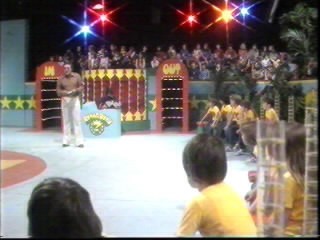 The set of Runaround
The set of RunaroundApart from the usual Q&A stuff, guests were brought into the studio to either do a little performance (e.g. a Chinese Dragon troupe) or show off a whizzy bit of kit (sports cars etc.) Further questions would be based around what you'd just seen.
At the end of the game, the balls would be counted up, and the child with the most was given first choice at the prize stand (usually the star prize of a bike or some such).
Catchphrases
"G-g-g-g-go!"
"Runaround... now!"
Inventor
The Runaround format was devised by Merrill Heatter and Bob Quigley.
Trivia
Gary Crowley (yes, the bloke who presented The Beat) hosted a spin-off called Poparound based on music questions, and using gold and silver disks as the scoring tokens.
One of the directors was J. Nigel Pickard, later a supremo at Children's BBC and later grown-up telly on ITV.
Merchandise
Runaround annuals and quiz books were published.
Web links
Pictures
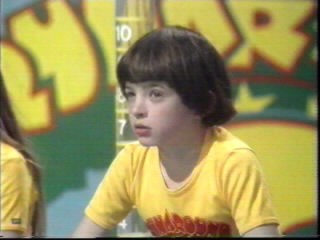 Picture 1 - A Runaround contestant (with scoring tube in background).
Picture 1 - A Runaround contestant (with scoring tube in background).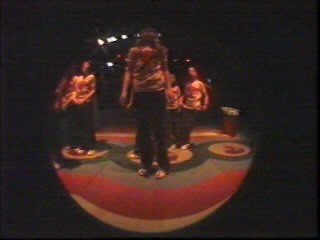 Picture 2 - Contestants about to give their opponents the runaround
Picture 2 - Contestants about to give their opponents the runaround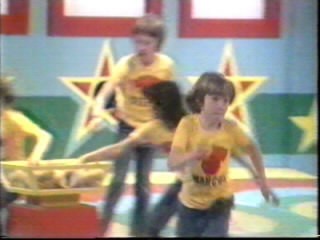 Picture 3 - The correct contestants pick up a yellow ball.
Picture 3 - The correct contestants pick up a yellow ball.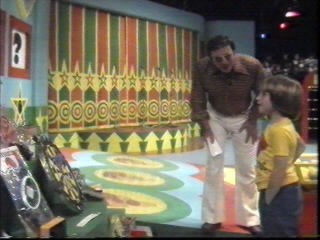 Picture 4 - The pile of prizes
Picture 4 - The pile of prizes 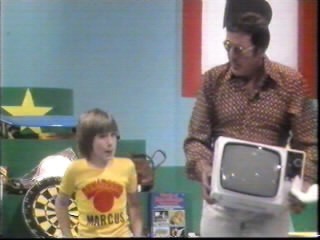 Picture 5 - The kid chooses the expensive telly. No surprise there.
Picture 5 - The kid chooses the expensive telly. No surprise there.
